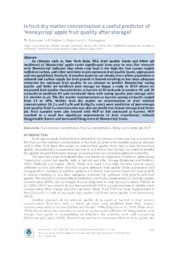Is fruit dry matter concentration a useful predictor of 'Honeycrisp' apple fruit quality after storage?
Is fruit dry matter concentration a useful predictor of 'Honeycrisp' apple fruit quality after storage?
Author(s): RUFATO, A. de R.
Summary: In climates such as New York State, USA, fruit quality (taste and bitter pit incidence) of "Honeycrisp" apple varies significantly from year to year. Our research with Honeycrisp? indicates that when crop load is too high the tree cannot supply sufficient carbon, and other nutrients to give optimum fruit quality (taste, appearance and storageability). Similarly if weather patterns are cloudy, tree carbon acquisition is reduced and carbon supply for fruit growth is limited resulting in less than adequate resources for optimum fruit quality. In an attempt to predict "Honeycrisp' eating quality and bitter pit incidence post storage we began a study in 2013 where we measured fruit quality characteristics at harvest of 30 orchards in western NY and 20 orchards in northern NY and correlated them with eating quality post storage after 4.5 months in air. The dry matter concentrations at harvest among orchards ranged from 11 to 18%. Neither fruit dry matter no concentration or fruit mineral concentrations (N, Ca and Ca/N and K+Mg/Ca ratio) were predictive of post-storage fruit quality. Fruit Ca concentration was also not predictive of post storage fruit bitter pit. Fruit samples were also treated with MCP or left untreated at harvest. MCP resulted in a small but significant improvement in fruit crunchiness, reduced disagreeable flavors and increased liking score of ?Honeycrisp? fruits. Keywords: fruit mineral concentration, fruit Ca concentration, liking score, bitter pit, MCP
Publication year: 2017
Types of publication: Journal article
Unit: Embrapa Grape & Wine
Observation
Some of Embrapa's publications are published as ePub files. To read them, use or download one of the following free software options to your computer or mobile device. Android: Google Play Books; IOS: iBooks; Windows and Linux: Calibre.
Access other publications
Access the Agricultural Research Database (BDPA) to consult Embrapa's full library collection and records.
Visit Embrapa Bookstore to purchase books and other publications sold by Embrapa.

